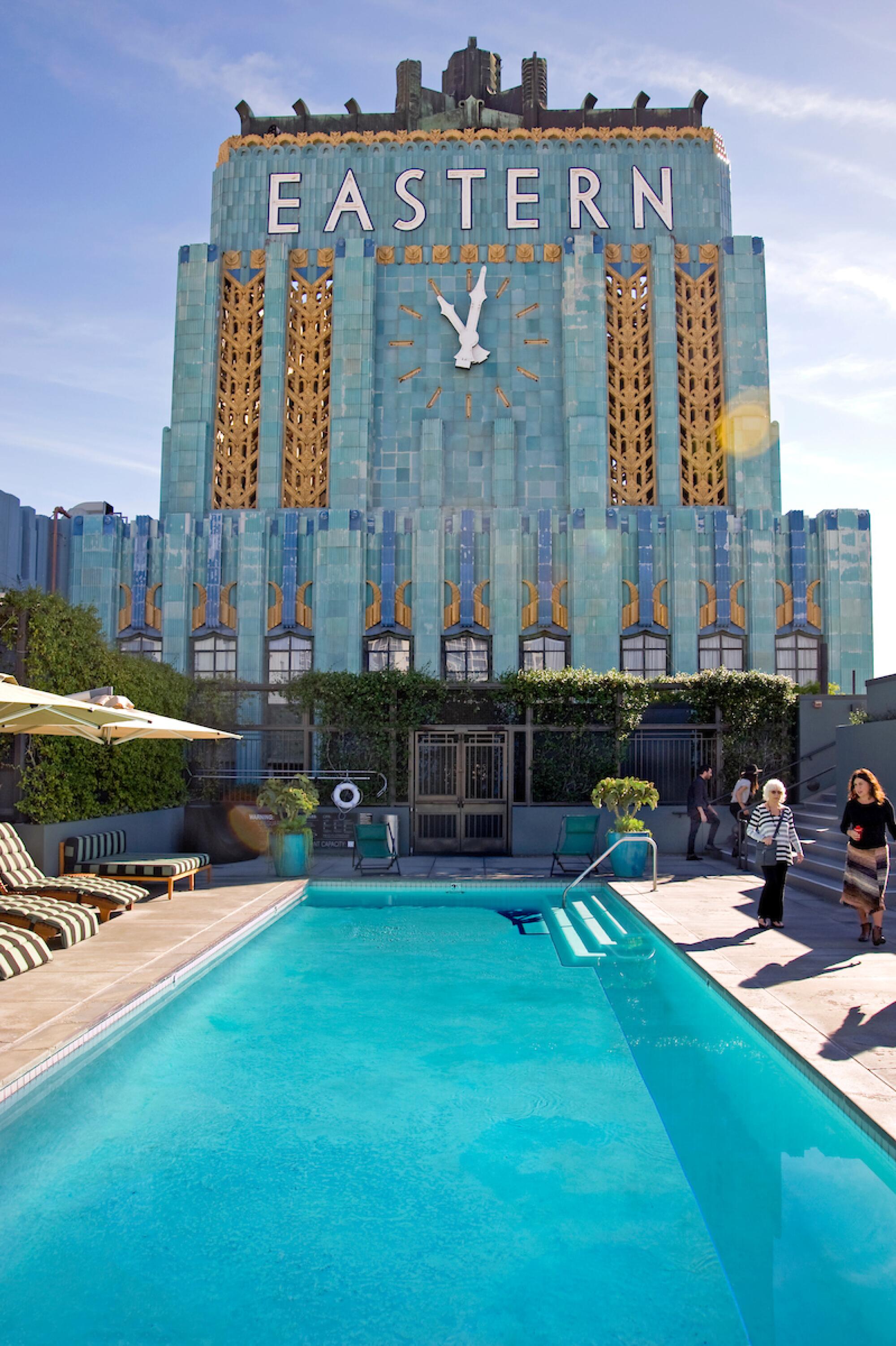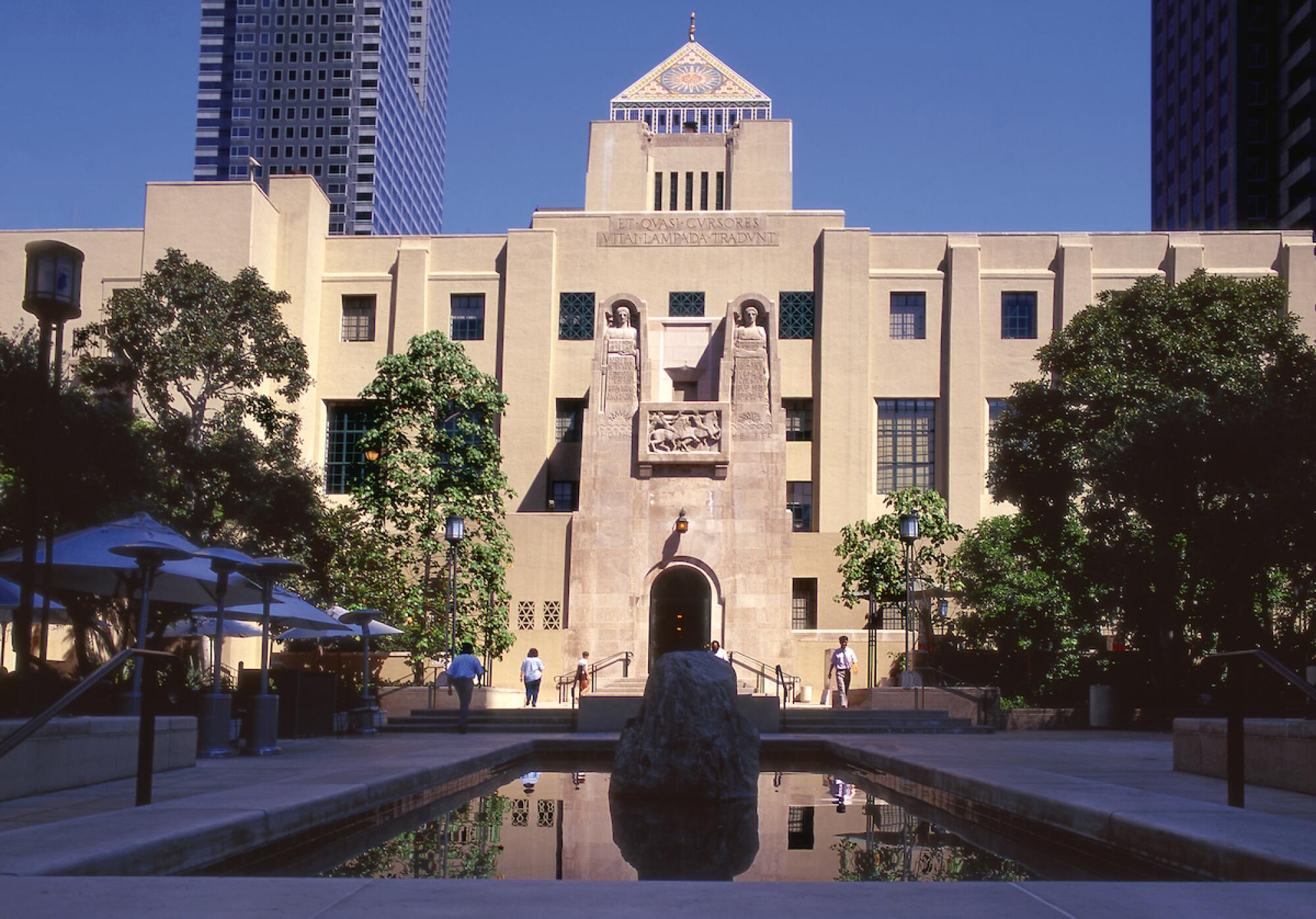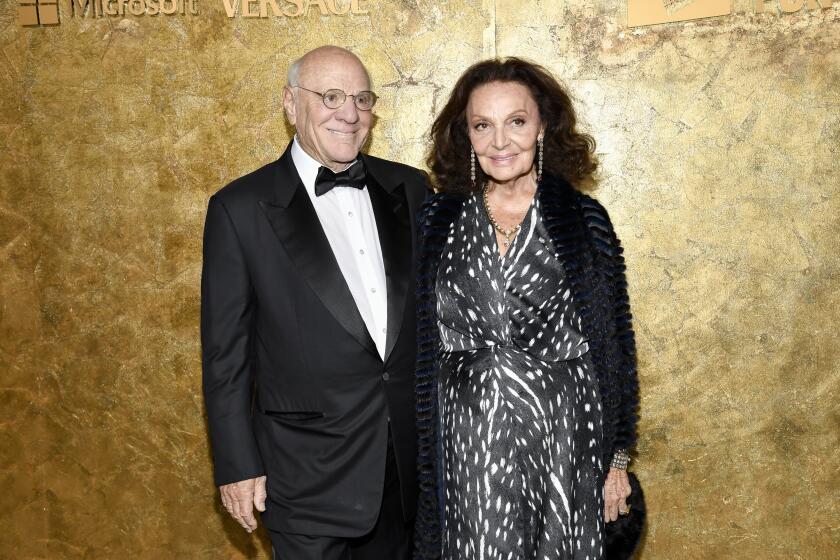
- Share via
Art Deco has never really gone out of style: Even after a century, the zigzag meanders, suave ladies and elegant lines associated with it still define sophistication.
The style gained popularity after being showcased at the Paris Exposition des Arts Décoratifs et Industriels Modernes in 1925, and to coincide with that centennial, West Hollywood’s Denenberg Fine Arts Gallery has mounted an exhibit showcasing photographer Robert Landau’s new book, “Art Deco Los Angeles.” In addition to Landau’s photos of beloved landmarks, some familiar and some reduced to rubble long ago, the Angel City Press tome includes an essay by author and architecture historian Alan Hess about the 20th century style known for bold geometric shapes.

“I was responding visually and emotionally to places I grew up going to,” Landau tells The Times of his photography, mentioning Pan-Pacific Auditorium as one such place. “Went there as a child to see Harlem Globetrotters,” he says of the sprawling Fairfax District structure near the Farmers Market that was destroyed by fire in 1989. “The ’20s, ’30s, ’40s was an exciting time, and people were inspired by the dynamics of things like automobiles and technology, and also making architecture that was fun and engaging.”
Designed by Wurdeman & Becket in 1935, the Pan-Pacific’s Streamline Moderne aesthetic echoed the Motorama auto shows that were once held there. A low-rise sprawling structure, it was an example of an L.A. iteration of Deco — horizontal versus the vertical style found in most cities.

“We have smaller-scale Deco here,” observes Margot Gerber, executive director of the Art Deco Society of Los Angeles. “For a long time, it was one or two stories, a sprawling metropolis. We used to have 150-foot height limits, but technology evolved so we can have taller buildings in L.A.”
Also in the book: the Mauretania, a low-rise apartment building designed in 1934 by Milton J. Black in a Streamline Moderne style that references the British luxury liner of that name, which set a transatlantic speed record in 1909. The 10-unit, stucco structure surrounds an open courtyard and is topped by an extensive penthouse where “Wizard of Oz” Tin Man Jack Haley once lived.

Other low-rise examples in the book include the Los Angeles Central Library (Goodhue and Winslow, 1926), Union Station (Parkinson and Parkinson, 1929) and the Griffith Observatory (Austin and Ashley, 1935), all emblematic of L.A. Deco.
Ornamentation on buildings has been around for as long as buildings, but the roots of Art Deco style are often traced to the work of Frank Lloyd Wright, his mentor Louis Sullivan and movements like Art Nouveau, Bauhaus and the Vienna Secession.

“You can see where they simplified all forms and took it out of what it had been in the classical period or the Victorian Age,” notes Gerber. “You look at Art Deco and it’s lighter, so black-and-white and so graphic.”
The book also includes modest homes, like one on Hudson and Larchmont that features a period stained-glass window but whose interior was remodeled in the Midcentury Modern style. Storefronts like the deserted Long Beach commercial building on North Atlantic Street are also pictured along with gas stations and tire shops repurposed as eateries and coffee shops.

Too many structures have been lost over the years, none as painful as the 1969 razing of the Richfield Tower, a 1929 office building in downtown L.A. designed by Morgan, Walls & Clements, the firm also behind the Mayan Theater, Pellissier Building and the Wiltern.
“It’s increasingly difficult because of state mandates for housing. And a lot of limitations on development have been lifted,” says Gerber about the fight to preserve these architectural gems.

She and others fought to get the Fairfax Theatre designated as a cultural monument, but despite that successful campaign the owner demolished the theater’s interior, leaving only the Art Deco facade, as required by law, with an open pit behind it.
Among the many Art Deco casualties are the Pacific Theatre on Wilshire (demolished 1988), Wilshire Bowl/Slapsy Maxie’s (demolished 1952), the Mole-Richardson Studio Depot on LaBrea (demolished 2014), Simon’s Drive-In Restaurant (demolished 1971) and the Four Star Theatre Building on Wilshire (demolished 2015).
“There’s a lot we thought were landmarked but just because you get designation does not mean the building cannot be torn down. You can tear down within a year of its nomination. Our hope is the kind of publicity we get with these buildings, they’ll become icons,” says Gerber.
“L.A. has not had a very good history of respecting its past, maybe because it’s still a relatively young city,” Landau says. “The May Co., they could have easily knocked that down and put a box there, but they didn’t and now it’s the Academy Museum. The public is coming around to understanding that a lot of these modern buildings that are put up don’t match in character or quality some of these buildings from the past.”

The son of L.A. gallerist Felix Landau, Robert began photographing the city in the late 1960s. Previous books include “Rock ‘n’ Roll Billboards of the Sunset Strip” and “Outrageous L.A.” The earlier images in his new book were shot on a Hasselblad in the 1970s and ’80s. For later images he used a Nikon D700.
“I grew up a black-and-white guy,” he says. “My heroes were the European street photographers — Atget, Kertész, Bresson. But here, the elements in the urban landscape are designed for cars driving by and they’re screaming for attention, and color is a big part of that. I do a lot of my shooting on weekends, Sunday mornings, and late in the day. The light comes through the atmosphere, sometimes smog, and you get color.”
Popular with the public in its day, Art Deco was rejected by the art and academic community in favor of the International Style, a sleek, minimalist sensibility seen in the works of practitioners like Richard Neutra and Philip Johnson, curator of a landmark 1932 MoMA show on the subject. Yet it has endured.
“People rejected Deco in the ’50s because it seemed like something that was old school and they wanted nothing to do with it. But it didn’t die,” observes Gerber. “The Oscars, the past five years, have done a very specific elegant Art Deco style to their set. Now the style is synonymous with timeless elegance. I don’t think it ever really disappeared.”
More to Read
The biggest entertainment stories
Get our big stories about Hollywood, film, television, music, arts, culture and more right in your inbox as soon as they publish.
You may occasionally receive promotional content from the Los Angeles Times.










